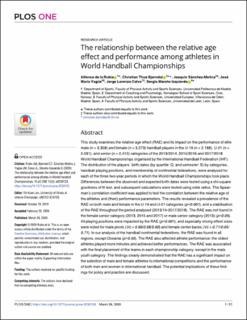| dc.contributor.author | De La Rubia, Alfonso | |
| dc.contributor.author | Bjørndal, Christian T. | |
| dc.contributor.author | Sánchez-Molina, Joaquín | |
| dc.contributor.author | Yagüe, José María | |
| dc.contributor.author | Calvo, Jorge Lorenzo | |
| dc.contributor.author | Maroto-Izquierdo, Sergio | |
| dc.date.accessioned | 2021-06-04T17:09:16Z | |
| dc.date.available | 2021-06-04T17:09:16Z | |
| dc.date.created | 2021-02-08T12:44:22Z | |
| dc.date.issued | 2020 | |
| dc.identifier.citation | PLoS ONE. 2020, 15(3), Artikkel e0230133. | en_US |
| dc.identifier.issn | 1932-6203 | |
| dc.identifier.uri | https://hdl.handle.net/11250/2758005 | |
| dc.description | This is an open access article distributed under the terms of the Creative Commons Attribution License, which permits unrestricted use, distribution, and reproduction in any medium, provided the original author and source are credited. | en_US |
| dc.description.abstract | This study examines the relative age effect (RAE) and its impact on the performance of elite male (n = 3,358) and female (n = 3,273) handball players in the U-19 (n = 2,188), U-21 (n = 2,031), and senior (n = 2,412) categories of the 2013/2014, 2015/2016 and 2017/2018 World Handball Championships organised by the International Handball Federation (IHF). The distribution of the players´ birth dates (by quartile: Q, and semester: S) by categories, handball playing positions, and membership of continental federations, were analysed for each of the three two-year periods in which the World Handball Championships took place. Differences between the observed and expected birth dates were tested using a chi-square goodness of fit test, and subsequent calculations were tested using odds ratios. The Spearman’s correlation coefficient was applied to test the correlation between the relative age of the athletes and (their) performance parameters. The results revealed a prevalence of the RAE on both male and female in the U-19 and U-21 categories (p<0.001), and a stabilisation of the RAE throughout the period analysed (2013/14-2017/2018). The RAE was not found in the female senior category (2013, 2015 and 2017) or male senior category (2013) (p>0.05). All playing positions were impacted by the RAE (p<0.001), and especially strong effect sizes were noted for male pivots (Vc = 0.66/0.68/0.60) and female center backs (Vc = 0.71/0.65/0.71). In our analysis of the handball continental federations, the RAE was found in all regions, except Oceania (p>0.05). The RAE also affected athlete performance: the oldest athletes played more minutes and achieved better performances. The RAE was associated with the final placement of the teams in each championship category, except in the male youth category. The findings clearly demonstrated that the RAE has a significant impact on the selection of male and female athletes to international competitions and the performance of both men and women in international handball. The potential implications of these findings for policy and practice are discussed. | en_US |
| dc.language.iso | eng | en_US |
| dc.subject | aging | en_US |
| dc.subject | anthropometry | en_US |
| dc.subject | careers | en_US |
| dc.subject | human performance | en_US |
| dc.subject | oceania | en_US |
| dc.subject | sports | en_US |
| dc.subject | statistical distributions | en_US |
| dc.subject | team behavior | en_US |
| dc.title | The relationship between the relative age effect and performance among athletes in World Handball Championships | en_US |
| dc.type | Peer reviewed | en_US |
| dc.type | Journal article | en_US |
| dc.description.version | publishedVersion | en_US |
| dc.rights.holder | © 2020 Rubia et al. | en_US |
| dc.source.pagenumber | 21 | en_US |
| dc.source.volume | 15 | en_US |
| dc.source.journal | PLoS ONE | en_US |
| dc.source.issue | 3 | en_US |
| dc.identifier.doi | 10.1371/journal.pone.0230133 | |
| dc.identifier.cristin | 1887627 | |
| dc.description.localcode | Institutt for idrett og samfunnsvitenskap / Department of Sport and Social Sciences | en_US |
| dc.source.articlenumber | e0230133 | en_US |
| cristin.ispublished | true | |
| cristin.fulltext | original | |
| cristin.qualitycode | 1 | |
